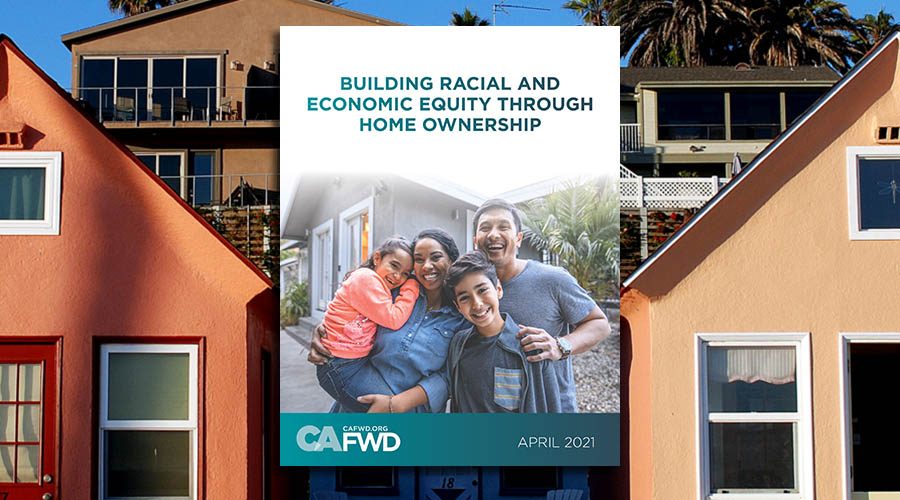
(Photo: Joe Wolf/Flickr)
It’s no secret that housing affordability has been one of the biggest challenges facing California for decades. It has also contributed to a massive racial wealth gap, as home ownership is the main driver of multigenerational wealth creation for the middle class.
A policy brief released today by CA FWD, “Building Racial and Economic Equity Through Home Ownership,” outlines how communities of color have historically been left behind in home ownership, how it affects their everyday lives, and what can be done to make home ownership more equitable.
“From the 1970s to now, we’ve (communities of color) decreased in home ownership, which has been the main avenue to increasing wealth in families,” said John Gamboa, California Community Builders board president and The Two Hundred vice chair. “The main avenue to address the poverty and the wealth gap is to use the same avenue that created the great white middle class in this country and that was access to home ownership.”
The brief highlights a $61.8 billion gap between the home price that California households making 60-150% of Area Median Income (AMI) can afford and the typical home price where these Californians live. Of that gap, Latino, Black and Native American Californians are disproportionately affected with a $35.5 billion gap or 58%, even though they are 45% of the population.
“California’s housing crisis results from decades of racial and economic inequities, which has disenfranchised countless generations of residents and disproportionately affected communities of color,” explained Ruby Bolaria Shifrin, director of Housing Affordability for the Chan Zuckerberg Initiative, which is working toward ensuring that everyone has a safe, stable and affordable place to live.
The inequity can be measured in dollars. According to the Federal Reserve Bank in San Francisco, white households have a median wealth of $355,000. That’s more than 100 times the amount for Mexican-American households with $3,500 in median household wealth and Black households not that far ahead with $4,000 in median household wealth.
“We’re looking at homeownership as the vaccine to address the illness of poverty. And poverty is the source of most of the quality-of-life factors,” said Gamboa, citing that health, education and race relations can be tied to one’s poverty level. “Right now, our communities of color are going backwards.”
The dream of owning a home and creating generational wealth is getting harder for communities of color. In 1980, a typical California home cost about three times what a typical household made. Today, a typical home costs about nine times what a typical household makes. This shows, without outside financial support, which is typically the older generations, home ownership is largely unattainable.
According to Bolaria Shifrin, an “all-hands-on deck” approach will be needed to bridge the massive gap. “To build a more equitable future for all Californians across the state, we’re working closely with community-based organizations, policymakers, and advocates to help produce, protect, and preserve critical housing assets. Transforming our housing system is a huge undertaking that needs the cooperation and collaboration between the business, civic, and advocacy sectors.”
CA FWD’s Expanding Home Ownership Work Group outlined their preliminary recommendations in the brief:
- Maximize the ability of the private marketplace to meet California’s affordable homeownership goals as the primary vehicle for achieving racial and economic equity. The strategy is to maximize the ability of the private marketplace to help regions in California meet ambitious Regional Housing Needs Allocation (RHNA) goals and produce the housing supply and types needed in California at price points affordable to 60-150% area AMI households comprised of communities of color.
- Provide targeted solutions where the market will continue to fail without augmentation. Where the marketplace falls short of meeting these goals, we should identify and prioritize scalable solutions to drive homeownership through the lens of equity and parity among racial and ethnic groups, gender, and geographical regions.
- Advocate for scalable capacity building where needed to meet California’s affordable homeownership goals. We should recognize where capacity development may be essential to produce the housing that is needed and should then identify and prioritize scalable solutions to meet our goals. Those include support for local planning departments, expanding the pipeline of skilled tradespeople, increasing education for first time homebuyers, and augmenting programs to increase the strength of black, indigenous, people of color and women led developers.
An equitable economy in California can only be achieved when decades of discriminatory policies and practices are recognized and new policies are enacted that make it possible for communities of color to realize home ownership and ultimately, generational wealth.
To get an in-depth look on this subject, join CA FWD’s Building Equitable Economies webinar on Affordable Home Ownership on Thursday, April 22 at 11 a.m.- 12 p.m. You can register here, listen to the discussion and ask questions. The webinar will include Bolaria Shifrin, Gamboa, Community Outreach Coordinator Ashley Gardner for California Housing Finance Agency (CalHFA), Director of Home Ownership for CalHFA Timothy Hsu, and CA FWD’s Senior Research Analyst Patrick Atwater.

